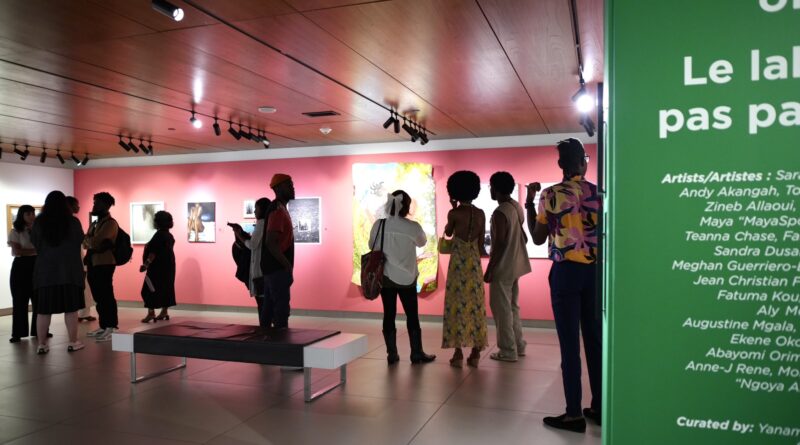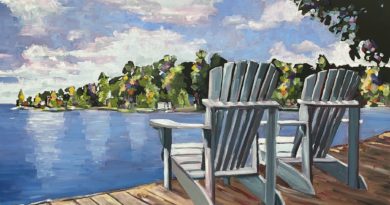The rest is history: OAG Guest Curator Yanaminah Thullah looks back on We Do Not Dream of Labour
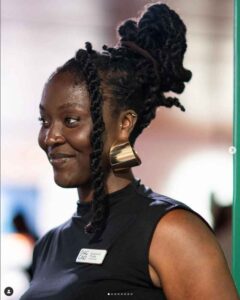
“Rest is not a given. It is a gift, and we can give it to ourselves.”
Under the constant pressure to hustle and grind, we often neglect the act of rest. And even when rest is prioritized, it is not always accessible.This is especially true for the Black community, due to colonial ideologies that have become embedded in our culture.“ Institutionally and systemically,” Yanaminah Thullah writes, “rest is not a privilege we have been afforded … Reclaiming rest transcends capitalism, colonialism and is both a critical and transformative step towards the liberation of the Black community.”
As part of that step, the Ottawa Art Gallery displayed the profound exhibition We Do Not Dream Of Labour this past summer. Including photography, paintings, poetry, sculpture and other forms of media, the exhibition offered a look into what rest means for the Black community.
It is important to note that “rest” here means more than just physical rest. The curation focused on the seven types of rest (as defined by Dr. Saundra Dalton-Smith): sensory, emotional, social, spiritual, physical, creative, and mental. The exhibit invited visitors to reflect on the multiple ways we may be depriving our bodies of the nourishment it needs.
SesayArts magazine sat down with Commercial, Community Guest Curator Yanaminah Thullah, to discuss the origins and elements of We Do Not Dream of Labour, and her aspirations for the exhibition and her own future.
SesayArts Magazine: How did you come up with the concept for this exhibition?
Yanaminah Thullah: It was really informed by what I was going through and what I felt like a lot of people around me were going through, in terms of this burnout, and how self-care can be integrated into our lives amidst capitalism. I think I grew up with so many expectations . . . or, I guess, negative connotations, looking at it like maybe laziness or being unproductive. It made me really look inwards, in terms of how I tied my politics to my work.
Last year, I was having a lot of health issues, both mental and physical. It’s just one of those things where you neglect yourself and try to ignore certain things, but your body always responds. The body always tells you what’s really wrong. My body told me, “Hey, girl, you need a break, and you’re never taking it,” so I thought, “Maybe I should try that.” What I did was really revolutionary: it changed my entire outlook on my life.
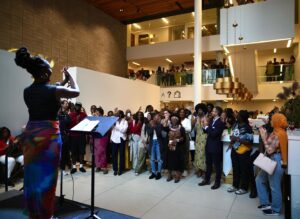
Maybe it’s just the social sciences student in me, but I started analyzing everything. Everyone is dealing with something like this, and where these expectations come from – particularly people in my community – so I started thinking more and more deeply about it. I knew I wanted to tell the story in some way. I never envisioned being a curator, but then I applied for the job . . . and I got it! And I thought, “Okay, time to tell the story.”
Sesayarts Magazine: You talk about the seven types of rest. Is there one type of rest that we see more in the exhibition?
Yanaminah Thullah: I saw a lot of emotional rest and creative rest. The name “creative rest” is a little misleading because creative rest is that rest you take to be in nature, in your surroundings – and the creativity that inspires.
Emotional rest is pretty self-explanatory, but I saw a lot of vulnerability and different expressions of the artist’s particular emotions when it came to rest. I saw pieces where people are crying, screaming, smiling, or angry. There were all of those, and in some paintings or photos, there weren’t even faces, but that in itself was expressing an emotion, you know? There were just bodies – and that’s what it feels like when we’re disconnected from ourselves. Whether it be depression, or constantly working, or doing things that make us operate on autopilot, we can neglect our actual thought processes and feelings because we’re performing to certain expectations.I noticed a running theme focused definitely on those two.
SesayArts Magazine: What were you looking for when you were choosing which pieces to include in the exhibition?
Yanaminah Thullah: It changed over time. At first, I was just looking for what fit the theme and . . . what’s visually appealing, of the quality that I would like and that the gallery expects.
But then, when I started seeing that thread I was talking about, I thought, “I want to be able to categorize these pieces in sub-themes, because that would really help me with the layout and help me tell the story, overall.”
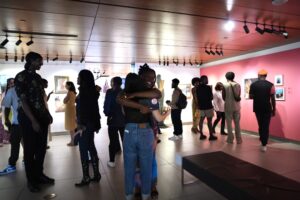
Then another thing . . . came to my mind. . . . I wanted to bring home the message that this story is not a monolith within the black community; it’s not a model in any community. There are so many narratives and so many ways to tell this story, so I want to show different types of media – not just painting and photographs, like we’re used to in galleries. I wanted poetry because I myself do poetry. I wanted sculpture. I wanted videos. So there are four or five different art styles there.
I was worried at first, thinking maybe it’s going to look messy. But no, I needed that variety . . . because I know that we’re all different. Some people are more audio-focused, and some are more visual. Even on an accessibility level, not everyone’s going to receive the message in one type of way. So I wanted that, as well.
It was around 60 submissions and each submission was one of five different types of work. So it was a lot to choose from!
Sesayarts Magazine: The exhibition is about rest over labour, but is the creation of art a type of labour? How would you define that in-between?
Yanaminah Thullah: When I was putting together the exhibition, I was looking at everything, even on a personal level – very meta . . ..There are 38 artists, so that’s a lot of messages, a lot of meetings, a lot of work. But then I was like, “I can’t champion this message without looking at the ways I’m managing my own self-care and rest in this process.” And when I did everything, up to even yesterday, I looked at it, and I thought, “You know what? I had moments of fatigue or just being tired, but it was never draining.” And it was never draining because it was a labor of love. I actually thought this to myself.
And then, coincidentally (or maybe it was not a coincidence), one of the artists in the show made a post asking (kind of like your question), “What is involved in creating this?” And he also said, “This is a labour of love. This is a labour that wasn’t labourious in the way we think. It wasn’t tiring” and it filled up his cup, in a sense.”
So I feel like, yeah, this required work, but it required a lot of people understanding me and providing teamwork and support from a place of love and care. And creativity, of course. So, it just had a different vibe than every other job I’ve ever had, for sure.
Sesayarts Magazine: What plans do you have for the future? What’s next for you?
Yanaminah Thullah: I wouldn’t say I have something else exactly lined up, but I know the space I want to reside in is one of working from a place of love and community and art, and expressing that in any way I can. If it pays me, great. If it doesn’t, also great.
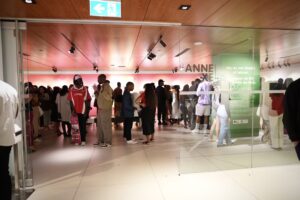
Ideally, it will involve more galleries, more spaces to represent underrepresented communities, and more expressions of creativity and joy and peace – especially when it comes to the black community. Because I think we see so many images – I’ve seen so many images – with negative portrayals of that community. But I want to see more positivity: not toxic positivity, but positivity that shows that there are other ways people can exist and live.
For my own life, I want to feel that way. And I want others to see that.
SesayArts Magazine: Is there anything else you’d like to mention?
Yanaminah Thullah: I just want to highlight that if it wasn’t for the Ottawa Black Art Collective, in collaboration with the Ottawa Art Gallery, I wouldn’t have this position. I’m grateful for the support they provided. They contributed to my own healing and self-healing, and I’m really thankful for that. So, I really want to shout them out – and, of course, the RBC Foundation for funding the position.
We Do Not Dream of Labour was on display until October 1, free to all visitors.
© Olivia DeSouza, Sesayarts Magazine, 2023
About The Author
Olivia DeSouza
Olivia DeSouza is SesayArts Social Media Community Manager & Magazine contributor. Read her full bio on About Us -> Meet The Team.

